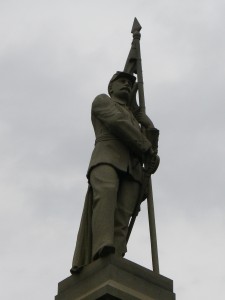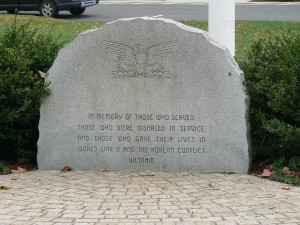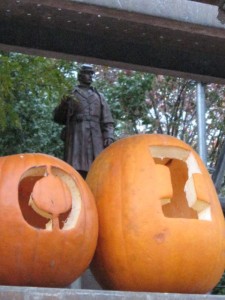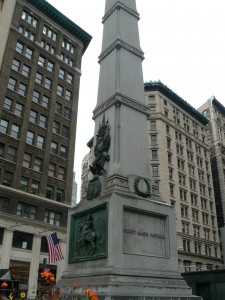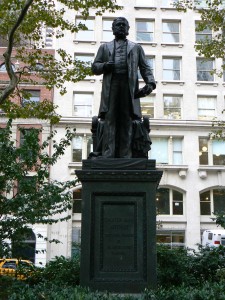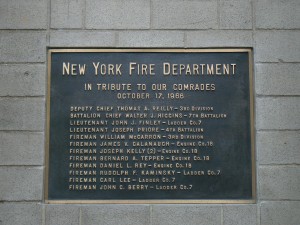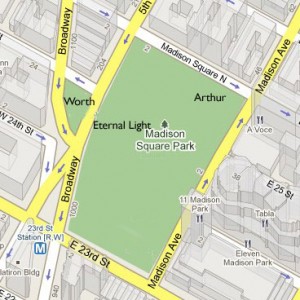 Portland honors its Civil War heroes with an 1872 obelisk made from local brownstone.
Portland honors its Civil War heroes with an 1872 obelisk made from local brownstone.
The front (northwest) face of the obelisk bears the dedication, “Erected May 30, 1872, by the town of Portland to the memory of her brave sons who gave their lives in defence of the Union during the war of the rebellion 1861-5.”
The northwest face also lists the names, regimental affiliations, and the date and location of death for seven residents lost in the conflict. The face also bears a carved eagle atop the Connecticut and U.S. shields, and lists the battles of Atlanta and Gettysburg.
The southwest face bears the names of seven residents, and lists the battles of Cassville (Ga.) and Chancellorsville (Va.) The southeast face lists eight names as well as the battles of Resaca and Peach Tree Creek (both in Georgia). The northeast face lists seven names and the battles of Silver Run (Md.) and Bentonville (N.C.)
Portland was once a leading producer of brownstone, a form of sandstone that was a popular building material in the late 19th and early 20th centuries.
 The Portland Soldiers’ Monument stands on a triangular green at the intersection of Main Street (Route 17) and Bartlett Street. The green also features two Civil War cannons. One cannon was manufactured in 1862, and the other was made a year earlier. The 1862 cannon barrel has an impressive cluster of insect nests that we chose not to explore further.
The Portland Soldiers’ Monument stands on a triangular green at the intersection of Main Street (Route 17) and Bartlett Street. The green also features two Civil War cannons. One cannon was manufactured in 1862, and the other was made a year earlier. The 1862 cannon barrel has an impressive cluster of insect nests that we chose not to explore further.
In the vintage postcard near the bottom of this post (which is not postmarked), the cannon are not on the small green, and the Congregational Church has a steeple that is not present today.
 A 1928 flagpole in the center of the New Haven Green’s eastern section honors residents lost in the First World War.
A 1928 flagpole in the center of the New Haven Green’s eastern section honors residents lost in the First World War.
The dedication on the east face of the monument’s eight-sided base reads, “In grateful memory of her heroic sons who fell in the service of their country, 1917-1918, the city of New Haven erects this staff, 1928.”
The other seven sides of the flagpole’s base bear bronze plaques that list the names of residents who were killed in the war.
The flagpole’s base also features a bas-relief depiction of allegorical and military figures.
The flagpole is surrounded by a fountain that was added to the site in 2003.
The 16-acre New Haven Green was established in 1638 to provide a common grazing yard for the young colony. The green served as the city’s first burial ground until 1821. British troops camped on the green during their 1779 invasion of New Haven, and the green remains a popular site for public events and political rallies.
 The southeast corner of the green features the Bennett Memorial Fountain, which was erected in 1907. The fountain was funded by the will of grocery magnate Philo S. Bennett, who also endowed political sciences prizes at several universities.
The southeast corner of the green features the Bennett Memorial Fountain, which was erected in 1907. The fountain was funded by the will of grocery magnate Philo S. Bennett, who also endowed political sciences prizes at several universities.
 Branford honors its Civil War veterans with a tall 1885 obelisk on a hilltop between Town Hall and the Congregational Church.
Branford honors its Civil War veterans with a tall 1885 obelisk on a hilltop between Town Hall and the Congregational Church.
The monument features a standard-bearer standing atop a granite obelisk. A dedication on the front (north) face reads, “Branford, to her brave sons who fought in the war of the rebellion, 1861-1865. One country, one flag.”
The north face also lists the battles of Antietam and Fredericksburg, and bears a Grand Army of the Republic emblem with two crossed rifles.
The west face lists the battles of Shiloh and Gettysburg, and the south face lists Vicksburg and Port Huron. The east face lists battles in New Berne, N.C, and Chancellorsville (Va.).
Four United States seals decorate the top of the shaft, just below the standard-bearer’s feet. The Branford monument is similar to the monument in New Haven’s St. Bernard Cemetery, which was produced by the same stonecutter.
A World War I monument on the south side of Branford’s Town Hall features a large representation of the Distinguished Service Cross medal. The monument was designed by local resident J. Andre Smith, and was dedicated in 1923 and restored in 2006.
 A granite monument beneath a flagpole in the center of the town green honors residents who were disabled or killed in World War II, Korea and Vietnam. The monument is not dated, but was likely dedicated in the late 1950s or early 1960s.
A granite monument beneath a flagpole in the center of the town green honors residents who were disabled or killed in World War II, Korea and Vietnam. The monument is not dated, but was likely dedicated in the late 1950s or early 1960s.
Tags: Branford
 A white concrete obelisk in Bridgeport’s Seaside Village honors residents who have served in the country’s wars.
A white concrete obelisk in Bridgeport’s Seaside Village honors residents who have served in the country’s wars.
The obelisk, at the southern end of a green located near the center of the village, bears a dedication on its front (south) face reading, “Dedicated in honor of those men & women of Seaside Village who have served their country and community in the Armed Forces.”
In a sense, the entire housing development is a war memorial. Seaside Village was built in 1918, during Bridgeport’s manufacturing heyday, to provide emergency housing for defense workers. About 257 units, most under 1,000 square feet, were built in a series of small brick buildings designed to resemble a European village.
The street names in Seaside Village are connected to World War I. For instance, Flanders and Alsace streets are named after battlefields. Albert Square, along the village green, is named after King Albert I of Belgium. Cole Street is named after Edward B. Cole, a Marine officer and expert on machine-gun warfare who was killed in France in 1918.
Sims Street is named after William Sims, commander of U.S. Navy forces in Europe during the war, and Burnham Street is named after Frederick Russell Burnham, an American explorer who served in the British Army before the war and would help inspire the international scouting movement.
 The complex was converted to cooperative housing in 1954, and remains an affordable, middle-class complex today. Seaside Village was added to the National Register of Historic Places in 1990.
The complex was converted to cooperative housing in 1954, and remains an affordable, middle-class complex today. Seaside Village was added to the National Register of Historic Places in 1990.
Tags: Bridgeport
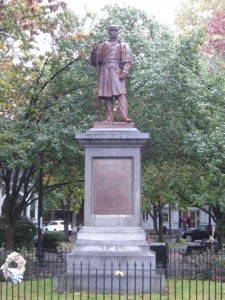 Keene, N.H., honors its Civil War veterans with an 1871 monument at the southern end of the town’s Central Square.
Keene, N.H., honors its Civil War veterans with an 1871 monument at the southern end of the town’s Central Square.
The monument features a bronze infantry soldier standing atop a granite base. A dedication plaque on the monument’s front (south) face reads, “Keene will cherish in perpetual honor the memory of her sons who fought for liberty and the integrity of the republic, 1861-1865. The honor of the heroic dead is the inspiration of posterity.”
The monument was created by Martin Milmore, an Irish-born sculptor whose other works include the Soldiers’ and Sailors’ Monument on the Boston Common.
The monument’s foundry was the Ames Manufacturing Company of Chicopee, Mass., which was also responsible for monuments in Middletown, Seaside Park in Bridgeport, and New Haven’s East Rock Park.
The Keene monument received an extensive cleaning and restoration during the late 1990s, during which a green patina was removed from the bronze infantryman.
 The large cannon near the monument came from the Portsmouth Navy Yard, and was placed in the square in 1899.
The large cannon near the monument came from the Portsmouth Navy Yard, and was placed in the square in 1899.
The photos in this post were taken on October 16 and 17, just before Keene’s annual Pumpkin Festival. During the event, Main Street was lined with a record-setting (for Keene) 29,762 decorated pumpkins.
(Thanks to Dad for the images.)
Tags: New Hampshire
 The city of Stamford honors veterans from the Colonial Wars through World War I with a 1920 monument in the heart of downtown.
The city of Stamford honors veterans from the Colonial Wars through World War I with a 1920 monument in the heart of downtown.
The Soldiers’ and Sailors’ Monument, in St. John’s Memorial Park, bears more than 4,400 names of residents on five large bronze plaques.
The monument bears the dedication “In everlasting memory of Stamford’s patriots 1641-1918,” near its top. A peaked roof is topped by a sculpture of three eagles.
The marble monument is based on an ancient Greek monument honoring Lysicrates that also served as inspiration for the 1904 Soldiers’ Monument in Seymour. The Stamford monument features nine columns, and the spaces between the columns honor significant battles in the nation’s various wars.
 For example, the American Revolution section, listing the years 1775-1783, honors the battles of Lexington, Concord, Bunker Hill, Ticonderoga, Trenton, Saratoga, Bennington and Yorktown.
For example, the American Revolution section, listing the years 1775-1783, honors the battles of Lexington, Concord, Bunker Hill, Ticonderoga, Trenton, Saratoga, Bennington and Yorktown.
The base of the monument features five large plaques listing the names of residents who served in the nations war. World War I has two plaques of it own, and shares a plaque with the Spanish-American War and the Civil War. A fourth plaque honors veterans of the Civil War, the Mexican War in the 1840s and the War of 1812, and the fifth lists residents who served in the American Revolution as well as the Colonial and Indian Wars between 1689 and 1763.
The World War I plaques list 26 columns of names, and honor 31 residents killed in the conflict.
The monument underwent an extensive cleaning in the summer of 2009.
A Doughboy statue with a fountain in its base stands near the southeast corner of the small park, which also features benches and walkways emanating from the Soldiers’ and Sailors’ Monument.
 Source: Connecticut Historical Society: Civil War Monuments of Connecticut
Source: Connecticut Historical Society: Civil War Monuments of Connecticut
Tags: Stamford
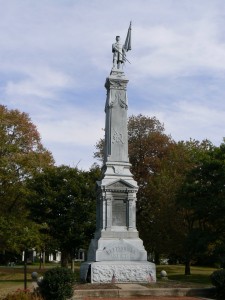 A 35-foot monument topped by a standard-bearer stands at the highest point of Stratford’s Academy Hill.
A 35-foot monument topped by a standard-bearer stands at the highest point of Stratford’s Academy Hill.
The Soldiers’ and Sailors’ Monument, dedicated in 1889, is unique in Connecticut because it was cast from zinc, a material that was marketed in the late 19th and early 20th centuries as “white bronze.”
A dedication on the front (west) face reads, “Dedicated to the memory of those who fought for liberty and saved the Union.” Below the dedication is a poem whose author is not credited on the monument: “Yet loved ones have fallen, and still where they sleep, a sorrowing nation shall silently weep, and spring’s brightest flowers with gratitude strew o’er those who once cherished the red, white and blue.”
The west side also lists the names of 21 residents killed in the war whose remains weren’t returned to Connecticut, and lists the battles of Gettysburg and Antietam.
The south face has a wooden panel that apparently replaces a decorative zinc panel, and lists the battles of Lookout Mountain (Georgia) and Olustee (Florida).
 The east face has a panel reading, “Erected by the Stratford Veteran Association and its friends, October 3rd, 1889. The Union must and shall be preserved,” and lists the battles of Chancellorsville and the Wilderness (both in Virginia).
The east face has a panel reading, “Erected by the Stratford Veteran Association and its friends, October 3rd, 1889. The Union must and shall be preserved,” and lists the battles of Chancellorsville and the Wilderness (both in Virginia).
The north face lists the battles of Fredericksburg (Virginia) and Fort Wagner (South Carolina), and features a decorative panel with an eagle, the U.S. shield, flags, a drum and crossed cannon.
The Stratford standard-bearer is uncommon in that the soldier has a sword in his hand. Most other standard-bearer monuments depict the soldier with his hand on a sheathed sword.
Zinc war monuments are very rare, in part because granite and bronze were more fashionable in the late 19th Century. For example, only one zinc regimental monument (honoring the Fourth Ohio Infantry) was allowed at Gettysburg, in part because veterans didn’t like the appearance of white bronze.
Stratford’s monument, like most white bronze cemetery markers, was produced by the Monumental Bronze Company of Bridgeport.
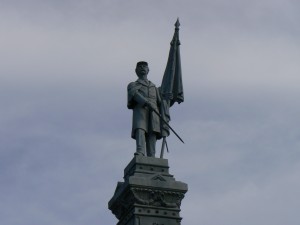 In addition, the material has difficulty supporting its weight when it’s used in large monuments. The Stratford monument has been renovated and reinforced, but remains split at the northwest corner of its base. By sliding a camera into the gap, you can take a photo of an interior structure added in recent years (as well as a large spider web inside the monument).
In addition, the material has difficulty supporting its weight when it’s used in large monuments. The Stratford monument has been renovated and reinforced, but remains split at the northwest corner of its base. By sliding a camera into the gap, you can take a photo of an interior structure added in recent years (as well as a large spider web inside the monument).
Near the Civil War monument is Stratford’s Walk of Honor, dedicated in 2005 to honor veterans of World War II and more recent wars. A large archway dedicated to World War II heroes bears the names of 97 residents lost in the conflict.
A Vietnam memorial bears the names of seven residents lost in the conflict. A Korean War monument bears nine names of residents who served, and a separate monument has been dedicated to honor disabled veterans.
 The walkway area is lined with bricks dedicated to local veterans.
The walkway area is lined with bricks dedicated to local veterans.
A tree northeast of the Soldier’s and Sailors’ monument was planted on October 27, 1958 to mark the 100th anniversary of Theodore Roosevelt’s birth.
Source: Connecticut Historical Society: Civil War Monuments of Connecticut
Tags: Stratford
 We’ll start our second post looking at the monuments in New York’s Madison Square Park (Part 1 is here) with the Eternal Light Memorial Flagpole on the Fifth Avenue side of the park.
We’ll start our second post looking at the monuments in New York’s Madison Square Park (Part 1 is here) with the Eternal Light Memorial Flagpole on the Fifth Avenue side of the park.
The monument honors residents who served in World War I. A dedication on the south face of the flagpole’s ornate base reads, “Erected to commemorate the first homecoming of the victorious Army and Navy of these United States, officially received by the city of New York on this site Anno Domini MCMVXIII (1918).”
The east face has been inscribed with the conclusion of the national anthem, and the north face bears a dedication “In memory of those who have made the supreme sacrifice for the triumph of the free peoples of the world.” The west face describes the perpetually lit star atop the flagpole as “An eternal light, an inspiration and a promise of enduring peace.” The dedication also provides the November 11, 1923, date of the star’s lighting.
 The base is also inscribed with the locations of notable World War I battlefields.
The base is also inscribed with the locations of notable World War I battlefields.
The original wooden flagpole was replaced with an aluminum version in 1976, and the star was restored and relit in 2002.
The Eternal Light monument was designed by architect Thomas Hastings, one of the designers of the New York Public Library’s main building.
William Jenkins Worth
On the other side of Fifth Avenue, a granite obelisk marks the grave of William Jenkins Worth, a Mexican War general who died in 1849 from cholera while commanding military forces in Texas.
 The obelisk, in a plaza known as Worth Square formed by the three-way intersection of Fifth Avenue, Broadway and 23rd Street, was dedicated in 1857. (Worth had been buried temporarily in Brooklyn before being moved to the Manhattan monument.) It is the second-oldest monument in Manhattan (an 1856 equestrian statue of George Washington in Times Square is the oldest) and, along with Grant’s Tomb, one of only two monuments in the city holding the remains of the person being honored.
The obelisk, in a plaza known as Worth Square formed by the three-way intersection of Fifth Avenue, Broadway and 23rd Street, was dedicated in 1857. (Worth had been buried temporarily in Brooklyn before being moved to the Manhattan monument.) It is the second-oldest monument in Manhattan (an 1856 equestrian statue of George Washington in Times Square is the oldest) and, along with Grant’s Tomb, one of only two monuments in the city holding the remains of the person being honored.
The south face of the obelisk features a bas-relief depiction of the general on his horse, and an elaborate trophy with crossed cannons, armor, two eagles, flags and a variety of weapons.
The east face has the Latin inscription “Ducit amor patriae” (Love of country leads (me)).
 The north face bears a plaque reading, “Under this monument lies the body of William Jenkins Worth, born in Hudson, N.Y., March 1, 1794, died in Texas, May 7, 1849.
The north face bears a plaque reading, “Under this monument lies the body of William Jenkins Worth, born in Hudson, N.Y., March 1, 1794, died in Texas, May 7, 1849.
The west face bears the dedication date along with the exhortation to “Honor the Brave.”
All four faces of the monument’s shaft list significant battles or postings from Worth’s career.
The monument was designed by Hartford’s James Batterson, whose firm supplied a large number of Civil War monuments in Connecticut.
The umbrellas and tables in the plaza in front of the monument are part of a market and food court that runs through November.
Chester A. Arthur
Returning to the northeast corner of Madison Square Park, we find a statue honoring Chester A. Arthur, the 21st president of the United States. The 1899 monument depicts Arthur standing with his left index finger holding his place in a book.
 The monument was designed by George Edwin Bissell, who was also responsible for Civil War monuments in Waterbury, Salisbury and other Connecticut municipalities.
The monument was designed by George Edwin Bissell, who was also responsible for Civil War monuments in Waterbury, Salisbury and other Connecticut municipalities.
Arthur, a protege of Roscoe Conkling (also honored in Madison Square Park), served as vice president under James Garfield and became president after Garfield’s assassination in 1881. Arthur had split with Conkling over political patronage disagreements, and Arthur’s anti-patronage reforms would help lead to the civil service system.
Arthur was a native of northern Vermont, and the fact that his parents owned a farm on the Canadian side of the border led to rumors and speculation that Arthur had been born outside of the United States, and was thus ineligible to serve as president.
23rd Street Fire
A plaque mounted on the outside wall of a hair salon across 23rd Street from Madison Square Park honors 12 New York firefighters who died in a 1966 drug store fire. The incident marked the second-largest loss of life for the department, behind only the 9/11 tragedy.
Tags: New York
New York’s Madison Square Park hosts an impressive collection of monuments honoring residents who served in World War I as well as 19th Century political and military leaders.
We’re starting the first of two Madison Square Park posts with Augustus Saint-Gaudens’ monument honoring Civil War Admiral David Glasgow Farragut, which is located at the north end of the park.
The monument, dedicated in 1881, honors Farragut, a career Navy officer who is probably best known for his “Damn the torpedoes” remarks during the Battle of Mobile Bay. The monument depicts a standing Farragut looking forward with binoculars in his left hand.
The monument’s base is a 1935 copy of a bluestone pedestal designed by architect Stanford White. Inscriptions on the two bench wings provide a dedication, in part, to “. . . the memory of a daring and sagacious commander and great-souled man whose life from childhood was given to his country but who served her supremely in the war for the Union . . .” and biographical details.
 The base was duplicated in 1935 (when the monument was moved from the corner of Fifth Avenue and 26th Street to the park’s interior) because the original had deteriorated.
The base was duplicated in 1935 (when the monument was moved from the corner of Fifth Avenue and 26th Street to the park’s interior) because the original had deteriorated.
William Seward
The southwest corner of Madison Square Park features a statue of William Seward, secretary of state for Abraham Lincoln, governor of New York and U.S. senator. Seward, who survived an attempt on his life the night Lincoln was assassinated, is perhaps best known for the 1867 purchase of Alaska from Russia.
The 1876 Seward monument, by sculptor Randolph Ranger, depicts a seated Seward with a quill pen in his right hand and paper in his left. Books are piled under his chair. The monument’s base has a simple dedication reading, “William H. Seward, Governor, U.S. Senator, Secretary of State of U.S.”
Roscoe Conkling
Near the southeast corner of the park is a statue honoring Roscoe Conkling, a Congressman, U.S. Senator and political boss closely associated with Chester A. Arthur (who is also honored with a statue in the park). The Conkling statue, dedicated in 1893, was created by sculptor John Quincy Adams Ward.
Until a few years ago, the Conkling statue was closer to the corner of the park, and faced southeast toward 23rd Street. After it was cleaned as part of the park’s recent restoration, it was moved a few yards west and reoriented toward the north.
The Madison Square neighborhood, like most in Manhattan, has fallen in and out of favor over the years. During the 19th Century, it was a fashionable home, restaurant and entertainment district, and the first two versions of the Madison Square Garden sports arena were in the neighborhood.
The Statue of Liberty’s torch and arm were displayed in the park for six years as part of fundraising efforts for the statue’s base.
Madison Square Park and its monuments have benefitted from an extensive renovation in the late 1990s. We attended college near the park in the late 1980s, and back then the park’s plantings were sparse, its statues were green and the Farragut monument had spray-painted graffiti. While we generally prefer to see bronze statues acquire a green patina over time, we applaud the other improvements in the park.
Sources: Madison Square Park Conservancy
New York City Dept. of Parks and Recreation
Tags: New York
 A monument in Litchfield’s West Cemetery honors local Civil War heroes, including 23 buried on distant battlefields.
A monument in Litchfield’s West Cemetery honors local Civil War heroes, including 23 buried on distant battlefields.
The monument, at the center of a cemetery section known as the Soldiers’ Lot, features a granite drum and the simple inscription, “Mustered Out.”
The monument was erected in 1894 as part of the dedication of a section of the cemetery for Civil War veterans who did not have burial plots. It would appear about nine veterans were buried in the section.
In 1903, the state of Connecticut erected 23 headstones to honor Civil War heroes who were buried in unmarked battlefield graves.
Soldiers’ Lot has a total of 35 headstones honoring Civil War veterans, and one stone honoring a local Marine sergeant who was killed in Vietnam in 1965.
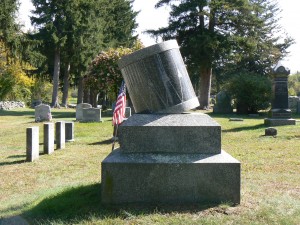 Four large cannonballs mark the corners of the soldiers’ section.
Four large cannonballs mark the corners of the soldiers’ section.










